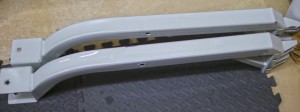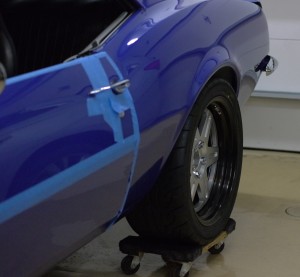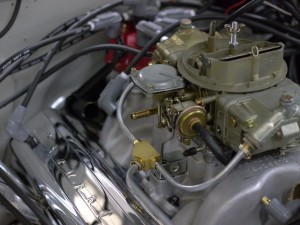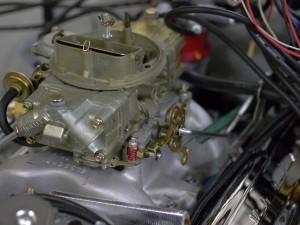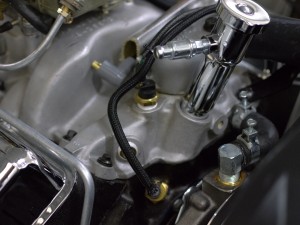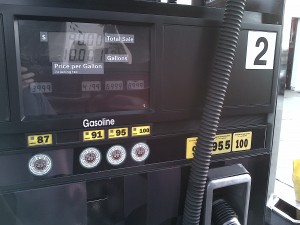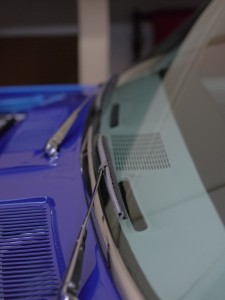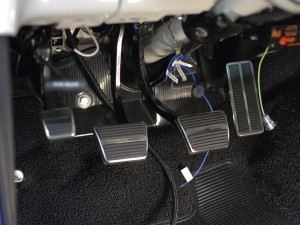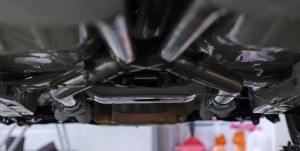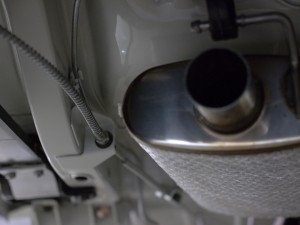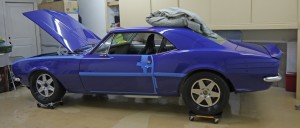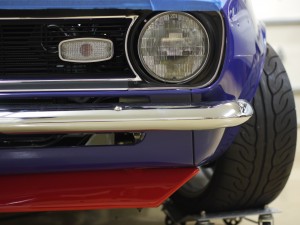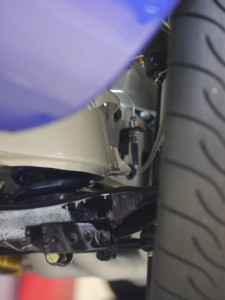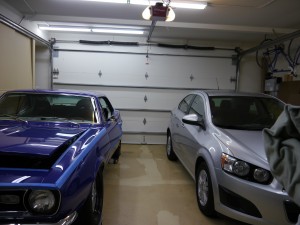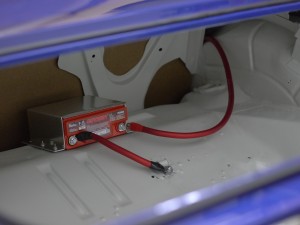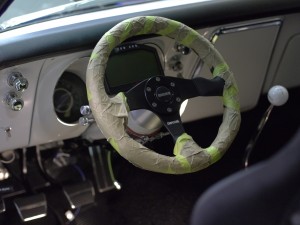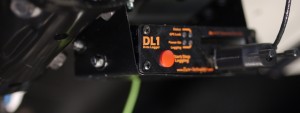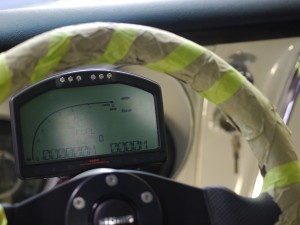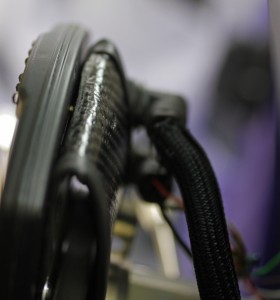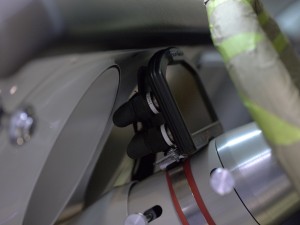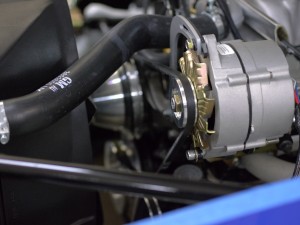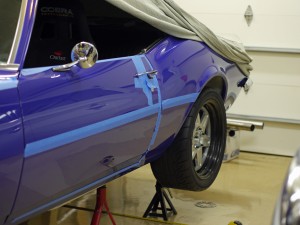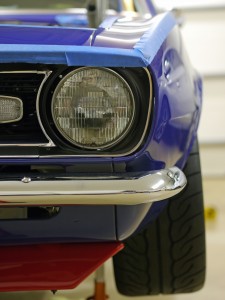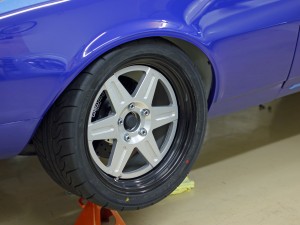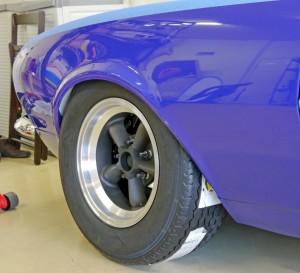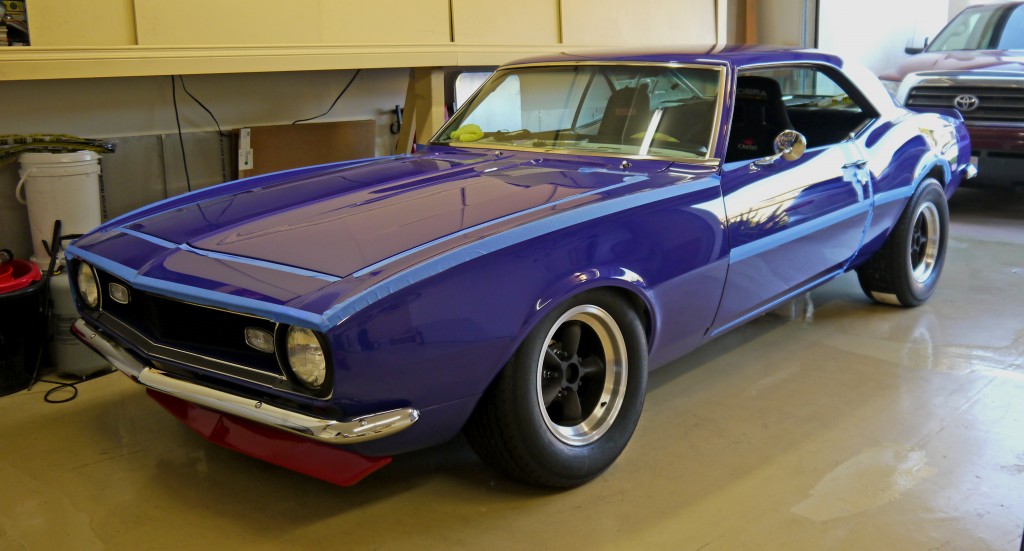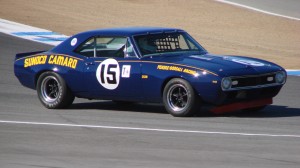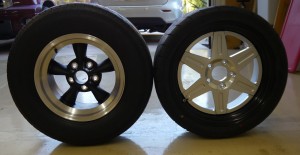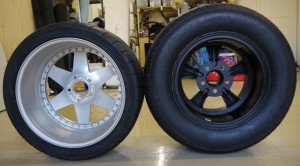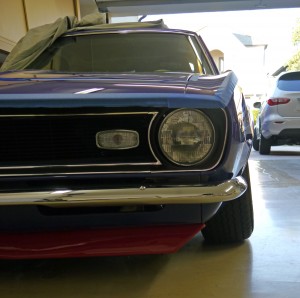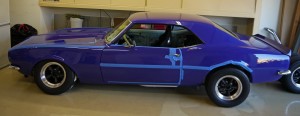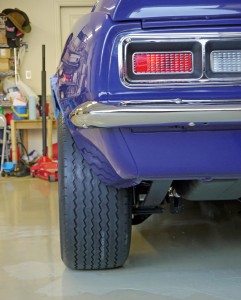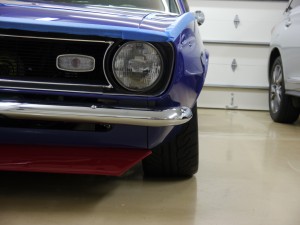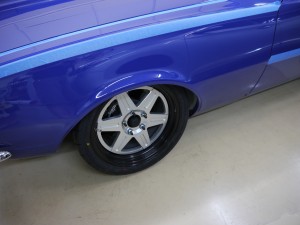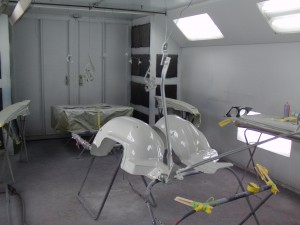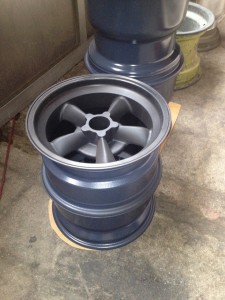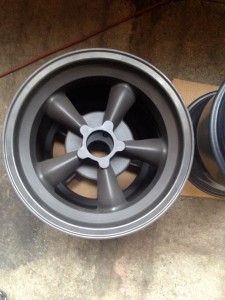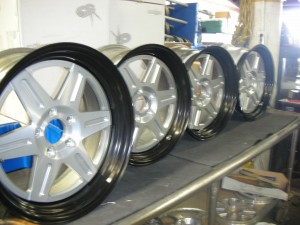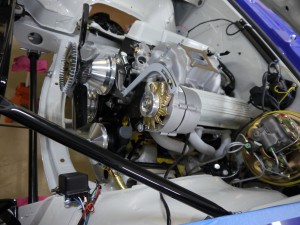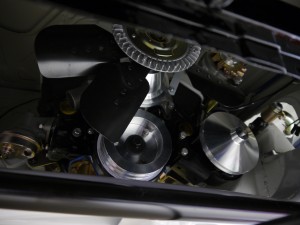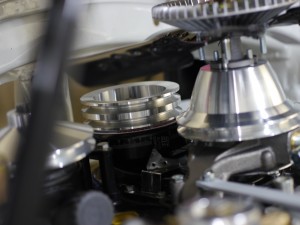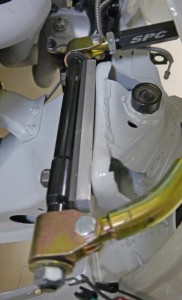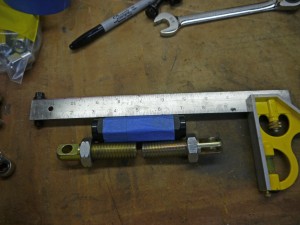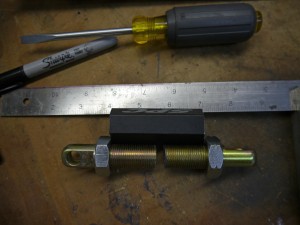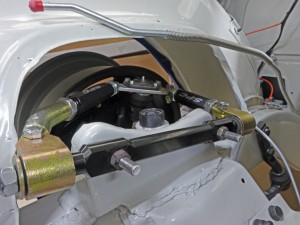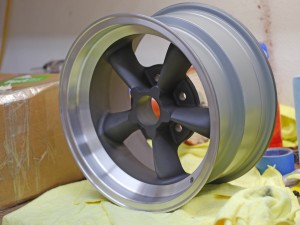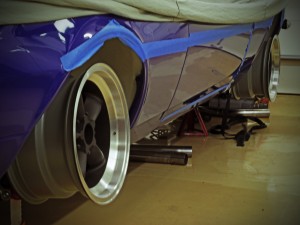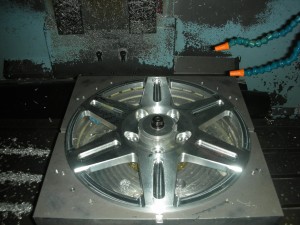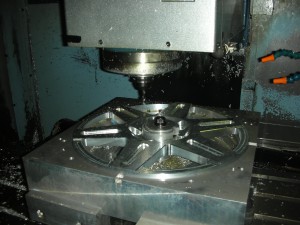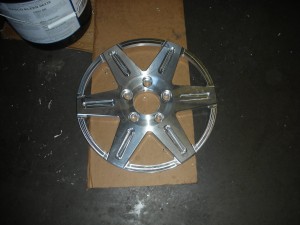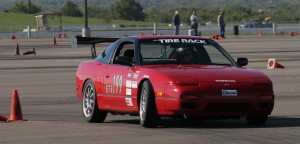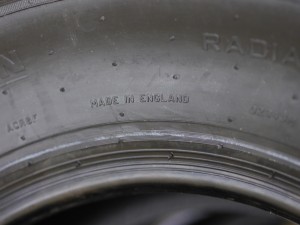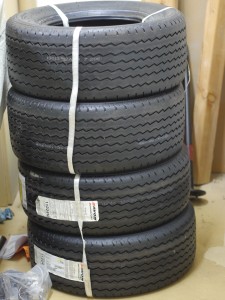Subframe (dis)connectors
Chock this one up as another oopsie-
The BMR subframe connectors appeared to be, and mostly were, a straightforward installation. Had John Coffey add a third attachment point to make them even better than off the shelf, and had them painted to match the underside of the car. They became the bitching-est bolt-in SFC’s ever assembled.
One problem surfaced later though – the way they mount, interferes with the stock routing for the fuel and brake hard lines.
This wasn’t immediately obvious, and I figured the difficulty I was having in getting those lines cleanly run (when provided with pre-bent stock replacement lines) was a figment of my own moronity.
Turns out it was, but not in the way expected. These SFC’s interfere with the way those hard lines are run by the factory, and my interpretation of the rules (“No alteration to the OE components is permitted.”), does not allow me to alter them to fit subframe connectors.
So the 24lbs. of “Non-Terminal Steelitis” the car came down with 2 years ago, has for now anyway, been cured.
Pulling the SFCs wasn’t too bad but the fuel and brake hard lines will have to be re-done, which is a bunch of work. Ugg.
Many obstacles overcome, still more to go.
About a month ago I posted a list of stuck-points on the project – fortunately since then, with a lot of effort and tool purchases, progress has been made! Have put more time into the car this past month, than in any month so far. First, an update on each of the old sticking points-
Power steering leakage
New pump was purchased and super-carefully installed. All lines cinched up, and no leaks after a couple weeks, yay! Still have to see how it holds up under the pressure of real use with the pump cranking away, but so far so good.
Brake line fitting leakage
This was due to an incorrect flex line in the rear – correct part ordered and installed, and the brakes were bled, no leaks! My brake bleeding assistant, who’s never driven a manual car, had some trouble with my instructions to “push the pedal in the middle” – since the throttle pedal was sunken to the floor, the clutch appeared in the middle of the e-brake, clutch, and brake pedals. I’m going from corner to corner, wondering why fluid is barely eking out as I hear her pumping away! 🙂 A little revised instruction and it’s good to go.
Still had some air after a couple passes, at which point I realized the multi-piston Wilwoods need to be bled at the top of both caliper halves (inner and outer) to get all the air out. Last few bubbles gone and the brake pedal feels very firm inside.
Leaf Springs
This was a rather labor intensive process. In typical easier-said-than-done fashion they were cut down 2.25″ in length; bushings were trimmed or hogged out to fit appropriate sleeves for mount bolts; the front spring eyes were flipped and ground for clearance; initially the rears were flipped also but it looked like clearance would be an even bigger problem, so they were left upright, but still got some grinding.
This has an ultra-scientific “one to two finger gap” in the rear. Added about 65 lbs. of fuel (more on that later) which only brought it down about 1/8″. Only weight left to go in is the headliner and door glass, so this is where it’ll be for now. It’s not likely this spring rate will be the one I wish to keep forever, so for the next pair of springs, it should be easy enough to request an additional ride height decrease, in addition to the spring length decrease. Bushing work will swap over.
Oh, and in the picture above, the rear wheel has 3/4″ of spacer. There’s room to go inboard or outboard bit if needed, but this provided a more athletic appearing stance, while still providing for tons of wheelwell clearance in all directions. At this setting rear track width is 70.75″, which still, isn’t *that* wide. It’s about 4″ wider than my 240sx was, and about 7″ narrower than the Viper.
Road Draft Tube
Have to thank my buddy John Coffey for talking me through this one. Tried several different things and took a long time with this, and ultimately found a solution. This item was holding up permanent installation for a lot of simple things in the engine bay, so once it was out of the way a lots fell quickly into place – carburetor, fuel lines, distributor, throttle and choke linkages, etc. The tube coming off the road draft vent hole is the black one fuzzily visible in the passenger side carb photo below-
You may note, the stock-style valve covers. These are actually the third set of valve covers I have for this thing – the first set didn’t fit the bolt pattern (they’re for an even older small block) and the second set were a bit bigger and made of thicker material. They *look* nice and original, but caused all kinds of interference problems with things like the fuel line and the bracket for the power brake booster vacuum line, visible above. While in general I’m not a fan of extra chrome, these are at least very lightweight, and totally stock.
Coolant Temp Sensor Port
This problem begat a bevy of tool purchases. After nothing could convince the old plug to come out, began drilling with ever-larger holes. The largest thing I had on hand for going through metal was 3/8″ (bits and chucks), so it was time for some upgraded hardware. Now have a new 1/2″ chuck drill, and an array of drill bits up to 1″ in size.
Also bought a 1/2″ NPT tap to repair the threads, and a special 45/64″ bit as the final pass before using the tap. After using the 45/64″ bit, all that was left of the plug was like foil and I could pull it out with needle-nose pliers.
Hooray! Coolant temp sensor in its appropriate location!
Also visible in this pic, is the new oil pressure sensor. This is a 1/8″ NPT sensor occupying a small port in the block previously filled with a small square plug. This too necessitated some tool purchases since it was a 7mm square plug, so none of my 6-point sockets would fit it, and the only way to fit a wrench on it, would be to pull off the water pump; no thanks. Ended up buying one of these universal socket things, advertised to work on 1/4″ – 3/4″ bolt heads of all shapes and sizes. After some monkeying, it got a grip on the thing and got it out. The tool earned its keep in that one action!
Perhaps apparent from the way the wires for the oil pressure sensor have been run, am making a big effort to keep the wiring tidy and professional in the car. Bought a ton of heat shrink tubing and overlay sheathing, in an attempt to keep everything clean, bundled, and protected.
Vent Windows
No progress on here from last time. The passenger vent window is just about ready to go in, been focused on what’s needed to get it running.
New Progress
Lots of other progress has been made in addition to getting the above accomplished.
First Fuel Purchase
One of the simpler ones – the fuel line installation was completed, so it made sense to get some gas. We happen to have a very neat retro gas station just a few miles from the house, that sells all sorts of good gas right at the pump, and comes complete with a smiling young man offering to clean your windows or check your oil. It’s mostly frequented by the well-to-do’ers of RSF, topping off their Range Rovers and exotic sports cars. I felt out of place with two crummy 5 gallon plastic jugs in the pickup, but the Camaro will look right at home there.
Oh, and this is the only station I’ve bought gas in, in the last 10 years, where you don’t have to pre-pay. Got a lucky click-off of the pump, no coins! Hopefully a sign of good ProSolo reaction times to come. 🙂
Windshield Wipers
This is another that seems like a no-brainer…which of course wasn’t.
Had the body shop install the wiper motor and attach to the wiper arms at the body shop, as doing so requires having the cowl panel off, and installation or removal of a body panel, is a big opportunity to scratch up the paint on said panel.
Unfortunately the wiper arms were not “clocked” to the motor correctly, causing the wiper blade to want to swing down initially, instead of up. So off came the cowl panel, some time spent futzing with the mechanism orientation, but ultimately, the wipers made it in, and I managed to get the cowl back on without messing anything up too badly.
The car had no wipers when I got it, now it has working ones, ha!
Pedals and Header-back Exhaust
The car has four functional pedals at last! Well, the gas pedal may not make it go yet, but it does open the throttle, now that the road draft tube shenanigans were handled.
Brakes were made ok with the bleeding a little while back, and the clutch was okay, as the pressure plate provides most of the springing, but the complementary clutch return spring that keeps the pedal up against the stop, has also been installed.
The parking brake pedal was the last to be made functional. The Wilwood rear disc brake setup on the car has a complete functional parking brake, but comes without a means of adapting it to the factory cable system. Fortunately the solution was pretty simple, with a pair of Lokar “Explorer style” clevises, drilled out to accept the factory parking brake cable. The entire parking brake system is not entirely new, from the rubber of the pedal pad, to the drum lining at each rear wheel.
As you can tell from the second picture, at this point, the exhaust ends at the mufflers. When I get the car to an exhaust shop, will have to see what can be done to extend the exit either to the traditional location, or out the sides. The panhard rod in the rear suspension complicates things.
Ride Heights
They still aren’t right. Rear is too high, as discussed above. I’ve raised the front “2 turns” (haven’t done the math to figure how that equates to inches), but it probably needs to come up more.
This picture was taken a few days ago, before fuel and coolant were added, so both front and rear have since come down a little bit.
You’d think moving the car around a garage floor on dollies like this would be easy – nope, big effort required!
Before trying to drive it anywhere, I’ll probably raise the front another 2 turns.
The Vintage mags with 27+” tall tires will fill the wheelwells better than the Jongbloeds and AD08 rubber. The shorter /35 series front tire vs. the /40 series on the rear, exaggerates the ride height difference.
No problem turning to full lock, even at this ride height-
Pic inside of the front suspension with the wheel turned- contact point at extreme bump, is the lower control arm to the factory bump stop bracket, welded on the frame. At this ride height, it has about 1.25-1.5″ of travel there, equating to about 2″ of travel out at the tire.
Oh, and a funny one-
The family car had to go in for service (Infiniti is paranoid after the Toyota/Lexus unintended acceleration debacle, and is issuing recalls on the new JX35 like crazy. The car needed 5 recalls done, which necessitated an overnight stay) – and since they were busy and out of branded loaners, we got a crummy rental – the Chevy Sonic. The Sonic is one of these economical small cars – not micro like the Smart or Scion IQ, but subcompact like the Toyota Yaris, Mazda 2, or Honda Fit. When my Tundra was serviced I got a Yaris SE loaner, which was actually decent, but this Sonic LT was crap! Anyway, it got to park next to the Camaro one night.
What amazed me was how TALL the Sonic is! Check out this picture-
It only looks a few inches taller than the Camaro…until we see the Camaro is sitting on 5″ tall dollies! Will have to measure the Camaro once it’s back on the ground, but I’m pretty sure its roofline is around 48″, the Sonic (and lots of other cars like it) have rooflines about 60″. Wow.
Battery
Ok, so I put it in the trunk, not very exciting. This is an Odyessy PC680, common in the aftermarket. It’s 13-14lbs., vs the 35+ of the stock battery, hanging way out past the nose. Here’s it’s mounted fairly high, but more or less at the rear axle centerline.
Have more thoughts on general battery placement, will have to share another time.
This battery was bought to get the car going (figuratively, not literally) – since in the beginning it is likely to get cranked a lot without much chance to charge normally, and this should stand up ok to that use. The *real* battery I plan on using is the C680 XS Power battery, which is only about 4 lbs., and is the same form factor as the PC680, meaning it will fit in that mount.
Interior
The insides of the car received some attention, mostly in the instrumentation area.
Steering was a bit out of whack, had to purchase a puller to get it all apart and re-clocked correctly, but it could at least be buttoned up-
The wrap will come off soon! Still getting my hands dirty doing stuff, just not as bad as before.
Note the cover plate over the center of the dash – bare as a no-option car can be.
Couple other things to see – the switch at bottom left, and of course the DASH2 dash. The switch will be an independent control of power for the DL1 and DASH2. The idea is, I can keep it on, to help let the DL1 keep GPS lock between runs, or any other time I want to have the engine off but instrumentation on. Modern cars tend to have as their key positions, Off -> Accessory -> Ignition -> Run. This car has Off -> Accessory + Ignition -> Run. Want to be able to keep some of the electronics going, without all of it going.
Speaking of the DL1, it got its own custom bracket, just below the dash, to the right of the steering column.
That silly bracket took a ton of time to measure and bend up, and I’m still not totally happy with how it ended up, as I had to change its position slightly to avoid having to use a serial extender between the DASH2 and the DL1.
With this configuration, the DL1 will be recording information from sensors (like coolant temp, RPM, and oil pressure) in addition to the things it can figure out on its own – speed and accelerations – and present this data to the DASH2, as configured, over an RS232 serial connection. This is handy, because you can’t really look at gauges while autocrossing. You might have a chance to look at the tach when doing an initial 1-2 shift, but that’s about it really. On the track you can take a glance for a second or so while on a straightaway, to ensure systems are still healthy, possibly even changing your approach if you see oil temps climbing, or something like that. In autocross you go out and hope the car makes it through the run without self-destructing. If you are having momentary drops of oil pressure, there’s no way you’ll see it, without some kind of alarm light programmed in, but that can be tricky, since 20psi might be OK at idle but death at 6k RPM. With the data acquisition, you’re watching the gauges 100 times per second, and if there are any concerning fluctuations, they can be correlated to other events, like hard right-handers following a braking zone, for instance.
In this photo it isn’t yet talking to the DL1, so it only knows to output fuel level, which it will get from the main vehicle harness, and will not be datalogged. Common Camaro Lore dictates one most always autocross a first or second gen Camaro with a completely full gas tank. I’m hoping that’s not actually the case, will find out soon enough.
The DASH2 is mounted to the steering column via a custom bracket I made. When I envisioned the bracket, it had to be carbon fiber, and making it so, took extra time. In trying to get a photo of it tonight, I now realize now silly that probably was, you can only really see it when looking down through the windshield. Here it is, from roughly the middle of the car up against the windshield, looking back and left-
Even if the aesthetics aren’t perfect, pretty happy with how it turned out functionally. The size and positioning of the bracket and DASH2 unit, allow the wheel its full range of tilt adjustment, without bind or interference. Here it is fully tilted up-
With the steering wheel in a normal position, eye level is slightly above the unit, which is supposed to be optimal for its viewing.
Race-Technology was very supportive in sending me out a loaner so I could get the car fired up, while they send my bricked unit back to the UK for repairs. Thanks Al Seim and R-T USA!
Belts
Not very exciting, was able to get a good length PS belt on the second try, looks like I’ll need a third attempt to get an alternator/fan belt of the right length, this one is a bit too long-
Looks like I may need to spend some time shimming the PS and water pump pulleys to get perfect alignment. Like so many things, you think belts will be a 5 minute deal, and it turns into hours… 🙂
###
The plan for the moment is to get it running, and solid enough to not fall apart or puke its fluids out everywhere on a short drive. Want to make sure it builds oil pressure by free-cranking it with the plugs out, before they go in and I try to fire it. It *should* be fine as it ran great on the engine dyno, but that was over 2 years ago, and it has since received a new oil pan.
It’ll need to go to an interior shop to get the headliner put in (it’s a least a 2-person, if not 3-person job on these cars), then to an exhaust shop (have some tweaks to the Magnaflow system I need/want), and to ProParts USA for some shocks. I want to have the car ready for the San Diego National Tour, which is a short three months away!
Interesting dimensions
As the car gets further developed some of the interesting questions from early on are finding answers.
One of those had to do with the car’s width. It is spec’d at 72.3″, which is quite a bit wider than the competition:
- E36 BMW: 66.9″
- WRX: 66.7″
- RX8: 69.7″
Over 2.5″ wider than the closest car, a significant difference. The general pages on this site around Transition and Skidpad performance go into detail on the pros and cons of width. Unfortunately in autocross, width is mostly a con. However, the measurement of width is not an exact science – where do you measure? Do you include things like door mirrors – which are high enough to miss cones and therefore not matter for autocross? Were all those cars measured in the same way?
A commonly used measurement is the distance, on the ground, between the outermost edges of the rear tires. That number best represents how wide your car’s ass is, and how careful you’ll have to be in getting it through the course without knocking things over.
Super Stock C5 Z06 Corvettes are usually around 72-73″ in this measurement. The C6 Z06 is a bit wider, in the 77-78″ range. The Viper is also about 77.5″. I also remember performing this measurement on James Gunn-Wilkinson’s 996 GT2 the year it won ASP nationally – it was only about 69.5″ wide, even with 335 tires on wide wheels. That was a real advantage over the ASP C5 Z06s, which had swelled into the 77″+ range to fit their big SP tires. Some CP cars have been measured over 80″ wide! Perhaps that’s why sometimes their driving efforts look like Kim Kardashian trying to make it through the turnstyle on the Paris Metro without touching the sides…
Given the specified width for the Camaro, was expecting a number for the rear in the 71-73″ range. Delighted to find, the value was only 69.25″. I estimate between 1/8″ and 3/8″ per side the wheels could be spaced outward, if needed. That’d get the rear width measurement up close to 70″, but still, that’s really not that bad. Besides the width penalty in transitions, an additional downside of adding rear track, is it increases the wheel speed differential between the inside and outside rear tires in a corner, which can be troublesome to certain types of limited slip differential. Narrowing rear track is a common trick in trying to mitigate diff problems. On the plus side, additional rear track reduces total rear weight transfer at a given lateral acceleration, leaving a little more weight on the inside rear tire for acceleration.
Since the Sunken Battleship post from a couple weeks ago, have since procured various spacers for the front end. Good news, looks like a full 1″ of spacer in front passes. Can even turn to full lock at ride height!
This is a much better situation – both for appearance and for performance. It’s only a ~3% increase in front track, but that means 3% less weight moved across the axle, which could mean as much as 1-2% more potential front grip. Next set of STX wheels will probably be built with a lot less backspace. Advantage of these, is the tires could be stood straight up (zero camber) and still fit ok with the spacers removed. 18×9’s with only 4.5″ backspace (which these effectively have now) will only fit right with a ton of negative camber on front.
Raised the front a little bit too from last time. It looks a lot less tucked, but a big part of that is this tire is about 1.5″ shorter than the vintage-style Avon.
With the spacers, the equivalent measurement to the one quoted above for the rear – 71″. Very pleased by that – a front track wider than rear should really help the chronic understeer these chassis seem plagued with. Front width is more manageable too when driving, largely because it’s part of what you can see!
Beautiful wheels, horrible ride heights
Yesterday the other two Vintage Engineering magnesium wheels showed up. There are the best replicas of the wheels used in the Trans-Am racing series you will find anywhere. I went with the American Racing Torq-Thrust 5-spoke design, though the Minilite design everyone had switched to by 1969, is also available.
Nobody really makes magnesium wheels any more, and there are a lot of interesting tidbits to know in the “care and feeding” of mags. Since they are cast, they have some fragility – you don’t want to use more than 25-30psi when seating the beads, as the explosive force of the tire seating, can actually damage the inner flange on the wheels, which is not generally repairable. Fortunately the Avons beaded up with under 20psi – these are no 30-series R compounds!
Second, you don’t want to use normal tire-mounting lubricants, because water and soap is bad for magnesium – especially so anything left inside the tire, as it will just sit and eat away at the metal over time. The barrels of these are painted, but it only provides so much protection. The tires were mounted today using a bunch of WD-40 as the lube.
Quick shout-out to the folks at the Discount Tire at Balboa & Genesee in San Diego. I have been going to those guys for years, and when other shops in town turned away me and my big and difficult-looking SM240 or Viper wheels and tires, the crew at this Discount always helped me out, getting things done quickly and without incident. If you’re in town I highly recommend them!
Third thing is that like Gremlins, you don’t want to let them get wet. Of course some moisture is inevitable, but if left on an unprotected surface, it causes magnesium to oxidize and eventually pit. Magnesium parts last a lot longer in dry climates – fortunately San Diego is arid/desert climate, and I’m far enough inland the ocean salt air is not a problem. The spokes and inner barrels of these wheels are protected with a “DOW 9” galvanic anozide – fancy chemical tech from WW2 which holds up and protects the magnesium better than paint can. Only the outer lips are left unprotected, which polish up beautifully, and can be protected with a corrosion-inhibiting oil like WD-40, though for these wheels I was recommended Gibbs by Ray Franklin at Vintage Engineering.
I really like these wheels. In looking at a million pictures of Camaros, it took me about 999,000 images before I realized why I prefer the looks of the classic Trans-Am cars over any of the megabuck modern Pro-Touring cars – it’s the tall sidewall on the modest-diameter wheel that does it. There are some nice modern designs out there in strong and light wheels from companies like Forgeline and CCW (remember I was originally considering CCW way back when) that are extremely popular with the restomod crowd – but unfortunately none of their designs really fit the vintage look. There are even a ton of manufacturers replicating the Torq-Thrust wheel design, but for one reason or another – spoke shape, colors, maybe even the grain texture in the aluminum used – nothing seemed to fit.
These Vintage Engineering wheels look exactly like what’s on the original vintage Trans-Am cars you’d see at the Monterey Historics – partially because a lot of those racers run these wheels too… 🙂
Since 18″ is today’s hot wheel diameter and all the good modern ST tires for the Camaro come in 18″ sizes, decided to attempt emulating the short-wheel, tall-sidewall look with the Jongbloed 214 wheels I had built for STX:
If you’re comparing these two wheels/tires from a distance, they don’t look much different. The one on the left has a silver lip with black center, the one on the right is silver from center to the lip…or is it?
A view from the back of the wheel tells the real story-
how state-of-the-art wheel & tire technology has changed a lot in 45 years. The Jongbloed here with a 265/35-18 Neova, has a sidewall that’s only about 3.5″ tall. The Vintage Engineering wheel with its 275/55-15 Avon CR6ZZ, has a sidewall that’s almost 6″ tall. This is just how modern when and tire design are going – larger and larger diameter wheels, with shorter and shorter tire sidewalls. There are benefits to this – more responsive tires, room for bigger brakes among them – but a lot of it seems to be to help make today’s huge cars appear smaller. Heck – the Infiniti JX35 you see peeking out in the photo below, comes with 20″ wheels from the factory!
On the offset/backspace/sunken battleship front, the Vintage wheels are not nearly as bad off. The fronts are only 4.25″ backspace, and as you can see in the first picture, they have no room to go further outboard, even if the car was raised an inch or two. From the front it still looks a little weird but not too bad I suppose:
With their shorter height, I should be able to get the STX Jongbloed wheels out at least this far. Sort of a bummer the Camaro’s inner wheelhouse is all metal – there’s another inch to go outboard per side without changing the fender’s exterior contours one bit, but doing so would require re-shaping the inner wheelwell structure, which isn’t permitted due to it being metal. Another two inches of front track width would be of tremendous benefit to front grip. One could conceivably raise the car up enough to allow for the track width increase, but that would be something like a 10% increase in (worsening of) CG height, in exchange for about a 3% increase (betterment of) track width. Not a worthwhile tradeoff.
Speaking of raising and lowering, ride heights are all wrong, this picture illustrates it best:
As mentioned in a recent post, the rear ride height is too high by about 3″, waiting on some new composite leafs to bring it down to earth. Front is too low, especially for these tires. They are 26.7″ tall front and rear, making the fronts about 1.5″ taller than the STX race wheels and tires.
Believe it or not, this looks a lot less bad than the car did on its 18″ Neovas. Partly because of the equal tire height here front to rear – the Neovas are 1″ shorter in the front than the rear, exacerbating the dragster-ish ride height weirdness. Next time the car’s in the air I’ll probably raise the front an inch or so, just to be conservative. Actually a little concerned I may not be able to make it through the gutter at the end of my driveway and onto the street, without damage.
Will be nice to get the rear lowered – at the moment it’s not doing a very good job of hiding its horse-and-buggy underpinnings!
You sunk my battleship
In part 4 of Comparative Vehicle Dynamics we went through looking at the key variables contributing to lateral grip and skidpad performance. Both these things are very important in autocross, where you spend the vast majority of time at the car’s lateral limit.
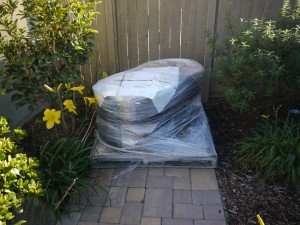 (Wheels and tires arrived on their own pallet, very nice!)
(Wheels and tires arrived on their own pallet, very nice!)
One of those key variables is track width – the wider, the less lateral weight transfer, and the more potential grip at the axle. This width ends up costing later in transitions, but my preference is still to take the wider track width, especially on a car that is somewhat under-tired compared to its competition. Especially too in the front, where the width tends to be a bit more manageable through slaloms. Especially three, in a car that has craptastic front suspension geometry, no ABS, etc.
When measuring for front wheels, most of the look-see was done at ride height, with the camber values around -1. I knew I’d run more negative for racing, but on the weird chance I ran more straight-up for the street or whatnot, wanted to be sure the wheel/tire wouldn’t be out of room outboard; a wheel too far inset can be pushed outward easily with spacers – ones too far outboard, require the use of those hard-to-find “negative displacement spacers” 😉
It looked like 5″ backspace might just barely be not enough backspace in front, and since it was easiest to step in .5″ increments, went with 5.5″ front backspacing. This was a bit of a bummer, since 5″ looked perfect (and after delivery still appears perfect) for the rear, meaning the front and rear wheels would (and do) have different dimensions.
When putting the car back on the ground for the first time in forever, I had the front suspension at its full -6 degrees camber. While the exact amount varies based on tire diameter and where you are already aligned, in general, for every one degree of negative camber you add, you move the top of the tire inboard by about .1″. So by adding over 4 degrees more negative camber from where I was when first measuring for wheels/tires, I moved the top of the tire inboard by over .4″, almost half an inch.
In the 240sx world when I owned mine, some people worked to get their wheel/tire combination pushed every last bit out to the limits inside their fenderwells. Tires so close to metal, you’d swear there’s no way they’d clear as the suspension moved, yet somehow they did. This was the pursuit of “flush stance” and those that achieved it were “hellaflush”. While this pursuit is mostly for looks, I happen to generally agree with the idea, as the further outboard you go, the more you’ve widened the track width. When done right, I think it looks good.
For every trend that gets branded, the opposite of the trend has to get branded too, and those that ran wheels/tires with too high an offset, or too much backspace, were said to have “sunken battleship” – because the wheel/tire appeared sunken into the wheelwell when viewed from the side. That’s how the Camaro looks with this backspacing – ugly and certainly not hellaflush!
I have some wheel spacers to go buy now for sure. Won’t be able to get the wheel/tire all the way out to the outer edge as is the modern style, with this car under the ST ruleset. The wheelwell is made of metal, and there is no allowance for its modification. Just inside of the outer blue fender, the inner fender has a flat plane for 1″ or so, before it forms a bowl shape upward. You can see it somewhat here, the wheelwell on the right has its outer portion facing the camera (inner portion is not a problem):
Because of this, the front of the car would either have to be up really high (blech!) or have a bit of the sunken battleship. I believe the wheels can go outboard at least 1/2″ from the above, possibly up to 1″ per side. Based on some Photoshop pixel math, it looks like the wheels need to go outboard 1″ to have the outer portion of the tire at the ground in line vertically with the exterior fender lip.
In addition to the extra track width on the end that needs it, this has the additional benefit of allowing for a bit more steering lock before the tires start to rub the frame inboard. But most importantly it should look much much better!!!
Would have a profile shot of the whole car on the ground at this point, but it looks ridiculous, as the rear springs are about 3″ too high. Like a wonky dragster, but worse. New rear springs are on order but will take while…ugg…
Few random pictures – two sets of wheels & engine compartment
Some of the prettier aspects of the car should be coming together soon. These first two are of the Vintage Engineering magnesium wheels, after coming back from receiving their DOW 9 coating.
Ray at Vintage then drills for the Camaro bolt pattern, and removes the coating from the outer lips with a scotch-brite pad on a lathe. When done they look like the other two I’ve already received. When they’re all here, will get the vintage-style Avons mounted up and put on the car.
Those are just for the street and any show-type activities though. The ones below are the real deal race wheels. 18×9″ Jongbloed 214 Aero, with custom backspacing, different front and rear.
Jongbloed mounted up my first set of brand new shaved ST tires on those today, should have them this week. Congrats to Mike Heinitz for correctly identifying the wheel pattern after I showed them in process back here.
Below are a few of the engine compartment, coming together, for real this time! 🙂 The March Performance pulleys look really great – they add a pop of shine without the obnoxiousness of chrome, and don’t betray the simple mostly-stock, all-business look I’m after.
With any luck I’ll have some rollers on this thing for some out-in-the-driveway shots this weekend.
Playing with the front suspension
While I should have spent the day doing something awful like bending fuel lines or polishing up ancient vent window trim, instead spent it looking at the front suspension.
The car is now sitting on the suspension, with jackstands under the front control arms and rear axle. Trying to get the bushings and springs to settle a bit, and get an idea of how much they’ll compress under the car’s weight.
Front spring perches are at a height placing the car where I believe its static ride height will be once it’s on the ground. It has about 1.5″ until the control arm hits the frame, which out at the tire is over 2″ of bump travel. Should be plenty to handle what’s out there, assuming there aren’t any big tire rub issues that pop up first.
I put the driver’s side together with the camber (rear) portion of the adjustable upper control arms fully shortened, maximizing negative camber. The factory upper control arm had an effective length of ~9.5″. The SPC arms I’m using, when fully shortened, have an effective length of ~8.5″.
With offset bushings in the lower control arms, the SPC arm fully shortened, and the car at what I believe will be its static ride height, the front suspension showed only 2.5 degrees of negative camber! That might sound like a lot for those accustomed to primarily street cars, where anything more than -1 is oddball. But for a racer, -2.5 in front is just about the minimum on anything – it might just barely be enough if you have fantastic camber curves, no body roll, and tires that are accommodating of modest camber settings. But everybody else at the autocross uses more if they can get it, and in the case of catastrophically bad geometry and lots of weight on a floppy 265 street tire, I will need tons more.
Good news is there are a couple options. The factory describes using shims at the upper control arm mounting point, to add camber and/or caster. I have a bunch of 1/8″ shims on hand, but then decided to make my own out of aluminum stock:
The silver material is 1/2″ thick, the darker stuff, 1/4″. 3/4″ is about as far as you can safely go with the factory UCA fasteners.
In building the shims and measuring how they affected camber, I found that for each 1/8″ of shim, the car would gain about 1/2 a degree of negative camber. Those values should be handy for any of the guys running stock-height spindles and factory pickup points.
So together those two shims added 6/8ths, or 3 degrees negative, taking it to a static 5.5 degrees negative camber.
That number sounds really too far out there, and I certainly hope to find that’s the case. At this ride height, the outer pivot point of the upper control arm appears parallel, or perhaps just slightly above, the inner pivot point. This is a good thing, meaning the UCA will be pulling the top of the spindle “in”, in a manner that should produce favorable negative camber gain. However the lower control arm is definitely past parallel, with the lower ball joint a little bit above the inner pivot point. This means the suspension is also pulling in the lower part of the spindle, a camber-robbing direction.
One helpful element, is the lower control arm is effectively ~16″ long, whereas our SPC full-short arm is only ~8.5″. The smaller radius of the upper arm should product lateral (inward) movement more quickly compared to the lower arm, hopefully passing it somepoint soon, and generating some negative camber gain. One could do something like the Guldstrand Mod – it lowers the mounting point for the upper control arm, putting it in a steeper part of its travel, generating more camber gain. Unfortunately relocating pickup points is not only illegal in ST, it’s illegal in most forms of motorsport – at least those that don’t also allow for a complete tube frame chassis.
Since the upper control arm is in a beneficial part of its travel at this ride height (which I believe is just about on the bump stop in a stock car) – there may be a better way than shims. What if one could shorter the upper arm even more?
The turnbuckle for camber adjustment on the SPC arm is 4″ long as delievered from the supplier. SPC does not appear to make a shorter turnbuckle-
So I made one, by cutting down each end of the turnbuckle by 1/2″, and cutting down the threaded inserts by an equivalent amount. The result-
With the turnbuckle now 3″ in length, the upper control arm can be shortened to 7.5″ in length, less than half the length of the lower control arm. Here it is on the car:
No clearance issues anywhere I could see, fits fine even at full short. An added benefit I was noticing with the negative camber, is the lower ball joint appeared to sit at a more natural angle. The lower control arm has a bit of a tilt to it, and with the stock upper control arm at this ride height, the car would normally have its camber about eight degrees more positive than this, equating to an extra eight degree of tilt to an already outward-tilted ball joint.
Still, not sure I will need this much. Won’t know for sure until some testing and tuning is done. I ran about -4.5 degrees on my strut-suspended 240sx, but it had a very compromised suspension at the ride heights I used, only losing camber in bump. I’ll have to do some more measurements with the springs out, but there’s a chance with this upper arm, the car is at least not losing any camber.
As stated elsewhere in this blog, I’m a big believer in providing yourself with a wide range of adjustability. You don’t ever want to be at the extreme of any of your self-defined adjustment ranges, for what if “more” in a given tuning direction, was better? In this case with no shims and the upper arms full short, the car has a ”
“natural” negative camber setting of over six degrees (which I have seen people use on tracked E36 BMW race cars). By lengthening the upper arm, camber could be brought to zero, and with shims, could go even further negative, to up past 10 degrees, which I couldn’t ever see needing. There’s also the possibility, if the short arm length causes issues, where it could be lengthened, in concert with shims, to maintain the same static value, but change the dynamic geometry to something less aggressive in camber gain.
Hopefully this is enough to begin to tame the Camaro’s front suspension demons!
First two “road & track” wheels arrived
Should go from having no wheels & tires, to two sets, in another week or two. Pleased to see these Vintage Engineering 15×8 wheels fit my aftermarket big brake setup front and rear.
These are the ones I’ll use up front, with 4.25″ backspace. With a 15″ wheel, that’s all you can go (maybe 4 3/8″ max) before you have interference with the outer steering boot. Rears will have a bit more backspace (4.75″) to help fit the big 275 rear tire.
The plan for these wheels is to use them on street and on the track, and for any show-type events. I’m not really a car show type of person, but with the right stickers, hoping it could pass as a Penske/Sunoco replica to the untrained eye.
Once the rear wheels arrive, will get the Avons mounted, and see how this thing looks on the ground! There’s a good chance my STX wheels and tires will be arriving at the same time, should make for a lot of fun photos!
Wheels getting made
Finally some progress on my wheel manufacture, got a couple pics to share of the centers being made:
Can anyone guess the make and model?
The car’s first set of tires
If you’ve followed along in my Comparative Vehicle Dynamics series, and you didn’t already know, you’ll no doubt come to the conclusion, that tires are an extremely important, if not the most important, part of a race car.
My 2006 run in the STS class was fueled largely in part by the availability of (for the time) next-generation tires for my 17″ wheel, 25″ diameter tire’d 240sx, vs. their 15″ wheel, 23″ diameter Civics. I’d had the chance to experience one of these tires (Yokohama Advan Neova AD07) the year before on an IS300, and knew they held a real edge over the Falken RT-215 still popular on STS Civics. I found I was even faster on the Bridgestone Potenza RE-01R released in 2006, even if I didn’t like the feel of the tire as much, as the Yokohama.
The point of all this, was the 240sx was a fun, but rather expensive experiment, where the hypothesis went something like “A car that has no business doing well, can not only be competitive, but possibly win in Solo, due to a small tire advantage”. I think this hypothesis was proved correct even if it wasn’t the fastest both days – besides, the 240Ssx ran away with the ProSolo win, as it was able to take advantage of its other strengths – namely RWD and torque.
So, tires matter a lot, and if there’s one place you can give yourself a meaningful advantage, it’s there. Chasing every last HP and ounce of weight are also useful pursuits, but in almost any case, I’d give those up to get a tire edge.
But unfortunately, there are only so many tires out there. The leading edge street tires are focused enough in their development, the odds of finding a ringer, that through some weird trick, happens to outperform 2012’s usual suspects (Toyo R1R, Yok AD08, Bridgestone RE-11, Dunlop Star Spec, Hankook RS3, Kumho XS, and now the Michelin PSS) is pretty much nonexistent. Plus the STAC wisely toughened the entry requirements for ST tires, mandating they be available in the same diameter/size counts as Stock-legal tires, which eliminated possible ringers like the Nissan GTR and Ford GT500 OEM tires.
As of this writing I don’t really have a good sense for where I’ll be going with the race tires for this car. Looks like there’s more coming out in the off season, so 2013 stands to be a lot different than the past couple years, in the tire makeup in grid.
It does look like I’ll need to run 18″ wheels though. I for sure want to run the class-max width size (265) and most manufacturers only offer that width in 18″ diameter. While this size defies the vintage look of the car, it does allow for a lot of additional backspacing in the front, making it easier to fit the tires. With 15″ wheels, I appear to only have about 4.25″ of backspace room, before the wheel would hit the steering arm. With 18″ wheels, I’m aiming for more like 5.25″ of backspace.
I do have some 18″ wheels on the way. They’ve been a work in progress the last several weeks, at a small race wheel shop here in California. If I’d gone with CCW I’d probably have received my wheels weeks ago, as Purner is so solid on turn-around times, but even though I’m going 18″ for race wheels, I wanted to go with a style that at least tried to look vintage. Purner’s stuff, even the “classic”, all felt a bit too modern for the car. Hopefully the style I’ve picked for this first set looks good, the wheel maker is so low volume, there are very few of his wheels out in the wild.
In all this research of tire and wheel makers, and looking at the universe of first-gen Camaros out there, I decided I pretty much hate every large diameter (>16″) wheel that’s been put on these cars. Some look less awful than others, but the styles are all so modern, they just seem to contradict the rest of the car. And it’s not just the wheels, the tire sidewall is a big part of it too. A modern 265/35-18 tire is about 25.5″ tall, with a sidewall height of only 3.6″. A vintage 7.00-15 Goodyear Blue Streak, is 26.7″ in diameter, with a sidewall almost 6″ tall.
If I’m working to make the car competitive in SCCA autocross, I’m going to run the best tire for the car I can, which means running the correct diameter wheels, which means probably not running on the car in autocross, what I think looks best, or suits the car best. Lots of work has gone into making the car look the way I want, and I was careful to allow backwards-compatibility with vintage-sized 15″ wheels. My interest in pursuing a vintage set of wheels and tires was piqued recently, when I came across a thread discussing vintage racing tires for Cobras.
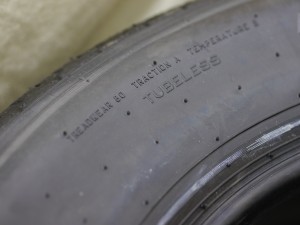
In it, many people spoke highly of a certain model Avon tire – the CR6ZZ. Available in tall sidewall sizes, but built with modern techniques and knowledge. Great on the track once warmed up, great in the wet, and fun on the street, with many people getting over 10,000 street miles in their hot rods. Only downside is cost – one set of 245/60-15 (front) and 275/55-15’s (rear) cost more than the last set of 335/30-18 and 345/30-19 Hoosier A6’s I bought for the Viper.
I figure these will last a lot longer than those A6’s – the Camaro isn’t likely to get many street miles, so these things are likely to die of old age before being worn out. Of course they supposedly they make great track tires, so they may see some use in that capacity as well. Ironically, since they are Treadwear 80 tires, I won’t be able to run them STX, even if I hadn’t gone with the wide 275 rear tire.
The wheels for these tires are a very special set, made by an even smaller wheel company than the one doing my 18″ wheels. This latter company, makes a lot of the wheels used by real vintage racers, the guys running the original Trans-Am and Can-Am cars at events like the Monterey Historics. Even when narrowing my search of wheels to original style and size 15″ Minilites and Torq-Thrust wheels, nothing available new today from the regular makers seemed to look right, except these guys. They just so happened to have four in their inventory, normally I’d have to wait 6-8 months to get a set, but instead I should have them soon.
Hope to get the car on the ground soon, on this vintage style wheel/tire setup. I’ve had the car sitting with jackstands under the suspension to try to get things to settle a bit, but the rear is still about 3″ too high, and there’s not much weight left to put in that’ll drop it, save for fuel.
